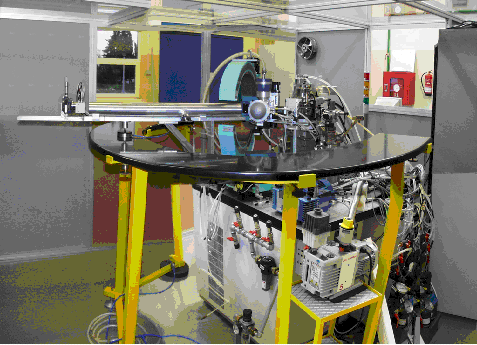With the support of the FCT, through a PRAXIS project, a high temperature X-ray diffractometer was projected and constructed at the Unit of Physics and Accelerators, within the High Resolution High Temperature X-ray Diffraction Laboratory. The diffractometer is a multipurpose instrument with applications ranging from the phase identification and determination of residual stresses on polycrystalline alloys to two-dimensional mapping of Bragg peaks in single crystalline materials. This instrument can perform diffraction experiments from room temperature up to 1400 ºC allowing in situ studies. These high temperature experiments, in particular on single crystalline samples, are very useful and also very rare.

The construction and installation of the Hotbird, a high resolution X-ray diffractometer, was finalized being now in operation. The success of the construction of the diffractometer resulted from a huge effort from a varied team of experts in different technical fields. Emphasis should be given to three particular aspects: the project of mechanical components, that were all constructed at the Nuclear and Technological Campus (CTN) machine shop; the project of electronic components and control boards; and finally the development of the software for remote control, data acquisition and data analysis.
With the Hotbird the team intends to study high temperature phenomena in superalloys, ceramics and semiconductors. The Hotbird is particularly suited to perform determination of internal strains, lattice mismatches between coherent phases, residual stresses and to observe the in-situ formation of intermetallic precipitates in implanted metals and semiconductors. The commissioning of such a diffractometer at CTN enables the team to carry out locally highly specialized experiments that will impart substance to collaborations with foreign teams and the training of young scientists.
The controlling software to perform the several experiments procedures (θ-2θ powder, ω-scan, ω-2 θ scans, etc.), the remote control of the generator, temperature control, data acquisition and some of the data analysis were also developed by the team:
Data Analysis Software
- Hotfit: fitting of spectra using several spectroscopic functions, indexing, etc.
- Spectra Adjust: manipulate data (add, collate, normalize, etc.)
- RSM Analysis: analysis of reciprocal space maps (strain, thickness, relaxation of layers...)
- 2D spectra adjust: manipulate 2D spectra (add, collate, create RSM, export formats, etc.)
Experimental Procedures
- 2D RSM: acquisition of Reciprocal Space Maps (RSM), omega-2theta, Psi-2theta and Phi-2thetaRSMs (strain and texture, etc.)
- Reflectivity: acquisition of reflectivity data (film thickness, roughness, density)
- Powder scan: generic acquisition routine for polycrystalline materials (e.g. phase analysis), triple-axis, grazing incidence, sequential, theta-2theta, Psi rot., phi rot.
- Residual stress analysis: acquisition of data (Psi method) for residual stress determination
- Texture analysis: acquisition of texture paterns
- Omega integral scan: acquisition of Omega integral Scans (also performed in the 2DRSM)
- Rocking curves, etc.
Remote control of hardware
- UltraX 18S rotating anode generator
- Goniometers (Huber 512.5, 1003.2, 9000, 9300)
- PSD detector (MBraun 50M)
- Slits (Huber 3012, 3013)
- High-temperature furnace
Software download section
The aim of the current section is to allow external users to download programs that were developed to remotely control some hardware components (Rigaku UltraX 18S rotating anode X-ray generator) and some data analysis software developed for the Hotbird (as Spectra Adjust and HotFit). However, they can be used in other environments.
- Hotfit - Version 1.3 Feb. 2001
- Spectra Adjust - Version 1.1 Feb. 2001
- UltraX - Version 1.1 Feb. 2001
Equipment financed by
Managing Authority and Funding
FCT – Fundação para a Ciência e a Tecnologia
Plano Nacional de Re-equipamento Científico
Project Reference: REEQ/814/CTM/2005
Designation: Upgrade and installation of a Small Angle Scattering X-ray
Spectrometer (SAXS) at the MA3T Laboratory and the 3 MV Tandem Accelerator at the Ion Beam Laboratory
(IBL).
Responsible Researcher: Eduardo Jorge da Costa Alves (ealves@itn.pt)
Access to the equipment: The equipment is available to the scientific
community both through collaborations within the framework of research projects or technical services. In
the later case, consumables and running costs will be charged to the users.
